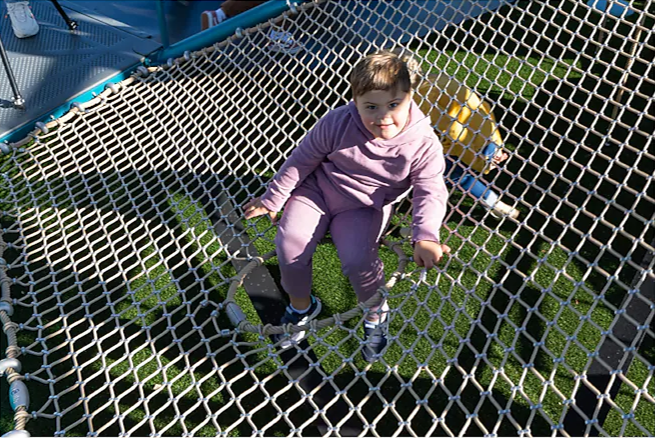Navigating Net Play: Challenges & Solutions for Inclusive Playgrounds
Net play isn't just about climbing and exploring—it's a vital component of the playground experience with numerous benefits for children's physical, cognitive, and social development. Net play promotes physical activity, helping children build strength, coordination, and balance as they navigate the various challenges presented by the structure. Moreover, it encourages sensory exploration and spatial awareness, stimulating cognitive development and problem-solving skills as children plan their movements and negotiate obstacles.
Beyond the physical and cognitive benefits, net play also fosters social interaction and cooperation, providing opportunities for teamwork, communication, and imaginative play as children collaborate to overcome challenges and create new games. Overall, net play offers a rich and multifaceted play experience that is essential for children's holistic development on the playground.
But while net play offers boundless opportunities for adventure and exploration on the playground, for some children, it can present unique challenges. Kids who fatigue quickly due to disabilities or struggle with motor coordination may find traditional net structures daunting. Understanding the motor planning process is key to addressing these challenges.
The motor planning process, also known as praxis, is the neurological process by which the brain conceptualizes, organizes, and executes skilled movements. It involves several interconnected stages:
- Ideation: This is the initial stage where the brain formulates the idea or plan for the desired movement or action. It involves imagining the task to be performed.
- Motor Planning: In this stage, the brain plans the sequence of movements required to carry out the desired action. It involves organizing the specific movements and coordinating them into a cohesive plan.
- Execution: This stage involves physically carrying out the planned movements. The brain sends signals to the muscles to execute the planned actions in the correct sequence and timing.
- Adaptation: Throughout the execution of the movement, the brain continuously receives feedback from sensory receptors in the muscles and joints, as well as visual feedback from the environment. Based on this feedback, the brain may make adjustments to the movement to ensure its success. This stage involves collecting feedback and modifying the approach for ease and efficiency.
The motor planning process is essential for performing both simple and complex movements, from everyday tasks like tying shoelaces to more intricate activities like playing sports or navigating playground equipment. It relies on the integration of sensory information, coordination of muscles, and precise timing to execute movements accurately and efficiently.
However, certain net structures, particularly those made entirely of cables, demand a high level of motor coordination, posing difficulties for children with conditions like ADHD, Autism, Down Syndrome, or Cerebral Palsy. Motor planning, the process of envisioning, planning, and executing physical tasks, can be particularly challenging for children with disabilities, presenting unique obstacles during playtime, especially in activities like net play. For instance, children with Cerebral Palsy may struggle with the motor planning required to navigate complex net structures, even if they can imagine the task they want to achieve. Similarly, kids with ADHD may find it difficult to organize their thoughts with their bodies, making it challenging to succeed on structures that demand high levels of motor coordination. While they may envision the task at hand, their bodies may struggle to execute it due to limitations in musculature or motor planning skills. As a result, complex nets can be overwhelming, inhibiting their ability to engage fully in play.
 Enter LSI Flexx™—a game-changing solution revolutionizing net play for children of all abilities. For years, Landscape Structures® has been on a mission to fill a gap in playground design, striving to create a universally engaging surface that stands up to the rigors of outdoor play. LSI FlexxTM achieves just that, leveraging a steel core for strength and the cable's memory for a playful bounce, all while providing a continuous surface with countless places to rest and explore.
Enter LSI Flexx™—a game-changing solution revolutionizing net play for children of all abilities. For years, Landscape Structures® has been on a mission to fill a gap in playground design, striving to create a universally engaging surface that stands up to the rigors of outdoor play. LSI FlexxTM achieves just that, leveraging a steel core for strength and the cable's memory for a playful bounce, all while providing a continuous surface with countless places to rest and explore.
In the world of playground design, innovation isn't just about creating something new—it's about making play accessible to all. That's where LSI Flexx comes in, a groundbreaking steel-reinforced cable netting material redefining the boundaries of inclusive play. Crafted from tightly woven, polyester-wrapped galvanized steel cables, LSI Flexx offers durability, stability, and a spectrum of play sensations from relaxation to bouncing to climbing.
But the impact of LSI Flexx goes beyond innovation—it's about inclusivity. Unlike traditional cable netting, LSI Flexx offers more support and places to rest, making it forgiving for children who are still developing their motor planning skills. Its continuous surface provides ample opportunities for exploration and practice, without the complexity of traditional net structures. By addressing the unique needs of all children, LSI Flexx embodies a commitment to inclusivity, transforming playgrounds into spaces where every child can thrive and play without barriers.
For children with disabilities, navigating traditional net structures can be challenging, from fatigue to motor coordination issues. LSI Flexx addresses these challenges head-on. Whether it's offering more surface area for comfortable rest or providing additional handholds for easier traversal, LSI Flexx ensures that every child, regardless of ability, can enjoy the thrill of play without barriers.
“Inclusivity isn't just a goal—it's a commitment. With LSI Flexx, we're revolutionizing play, one bounce at a time, ensuring that every child has the opportunity to soar, climb, and explore, regardless of their abilities.” ~ Landscape Structures

